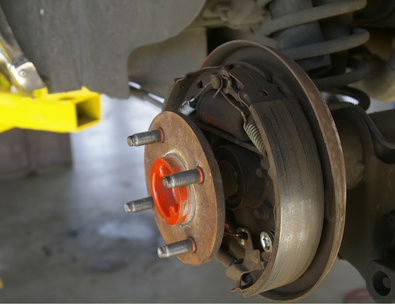
The bleeding of a vehicle's brake system involves flushing out and replacing the old brake fluid. Most manufacturers recommend that brake fluid be replaced every 2 to 3 years or when brake pads are replaced, but a more common reason for bleeding is soft, spongy braking action. This occurs when air bubbles become trapped in brake lines, causing a compressible cushion when brakes are applied. Not only will a thorough bleeding of a brake system flush out old fluid, it will also remove any trapped air and result in more efficient braking.
Place the car jack underneath the vehicle's frame, nearest the front wheel. Rotate the arm of the jack until the vehicle has been sufficiently lifted. Set a jack stand underneath the raised part of the frame. Repeat this step for the other front wheel and the two rear wheels, using four jack stands in total.
Remove all four tires using a lug wrench. Set all lug bolts aside in a safe place.
Locate the bleeder valve bolt on one of the rear wheels. These bolts are relatively small and are typically located just behind the brakes. Loosen them with an appropriately sized box wrench. Do not remove them completely.
Suck the old brake fluid from the master cylinder reservoir using a turkey baster, depositing it in a plastic bottle. In most vehicles, this is a small plastic container with a clearly labeled top lid.
Fit one end of plastic aquarium tubing over the bleeder bolt and place the other end into a plastic bottle. Fill the master cylinder reservoir with fresh brake fluid and screw on the lid. Place a 1"x4" piece of lumber under the brake pedal to provide a buffer during the bleeding process.
Instruct your assistant to depress the brake pedal and to announce when he has done so. While the pedal is down, loosen the bleeder bolt a quarter turn. Have your assistant remove his foot from the pedal. At this point, old fluid will trickle into the bottle. Repeat this step until clear fluid runs through the tubing. When it does, snug the bleeder bolt and remove the tubing.
Repeat Steps 3 through 6 for the other rear wheel and the two front wheels.
Replace all four tires and tighten the lug bolts.
Place the car jack under the frame near a jack stand. Rotate the arm of the jack so that the vehicle is lifted just high enough to allow for safe removal of the stand. Lower the jack and repeat for the three remaining jack stands.